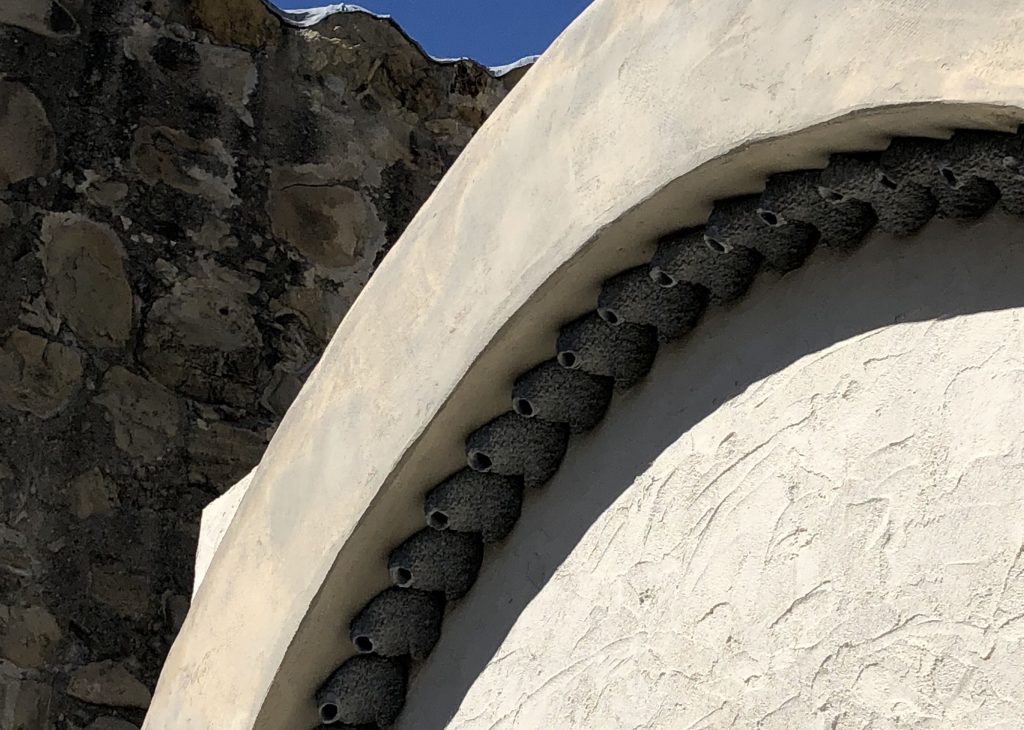March 19 is the feast of St. Joseph. Only many years after coming into the Church did I learn that it’s a day, for Italians at least, upon which Lenten fasting is (perhaps unofficially) lifted (except for meat).
Such is the fate of converts, sweating tears of blood as we refrain from, say, sugar, while real Catholics are laying out a feast.
But for those of us in Southern California, St. Joseph’s feast day has a deeper significance. March 19 is the day upon which, tradition has it, the swallows return to the mission at San Juan Capistrano.
The swallows migrate 6,000 miles each year from Goya, Argentina. Their scientific name, “Petrochelidon pyrrhonota,” refers in part to the rich red, “flame-colored” feathers on their necks and lower backs.
Legend has it that the tradition was started by Father St. John O’Sullivan, pastor of the mission from 1910 to 1933. Walking through the village one day, he came upon a shopkeeper angrily knocking swallows’ nests from beneath his eaves with a broom. Appalled at the birds’ evident agitation, Father spoke to them on the spot. “Come on swallows,” he invited, “I’ll give you shelter. Come to the mission. There’s room enough there for all.”
Supposedly, the very next morning the swallows began building their nests outside the Serra chapel. Father O’Sullivan went on to write a booklet, intended to raise preservation funds, entitled “The Little Chapters about San Juan Capistrano,” and to co-author “Capistrano Nights.”
March 19 falls this year on a Monday and will be celebrated at the mission in grand style, as it is each year. From 9 a.m. to 3 p.m. there will be mariachi music, Native American storytelling, flamenco, the ringing of the historic bells and more.
That would be way too much stimulation for my introvert soul, so I decided to visit the week before. I took the Amtrak Surfliner from Union Station, which is the most delightful, imaginable way to travel the California coast.
The city’s historic district lies just outside the mission gates and has been carefully preserved in order to welcome the more than 300.000 annual visitors.
You can easily walk the whole of downtown in an hour, including the lovely Los Rios District and the splendid Mission Basilica, a working Catholic parish.
“The Jewel of the California Missions” is no hyperbole. Adobe arches, red tile roofs, bougainvillea-festooned nooks and old stone fountains abound. Charming courtyards feature flowering agaves, camellias, citrus, lavender, crown-of-thorns and prickly pear.
The mission is, among other things, a carefully curated museum. In the chapel where St. Junípero Serra once celebrated Mass, the only such church still standing in California, you can kneel before the altar and give thanks.
Things have changed, of course, since Father O’Sullivan’s time. The mission used to be the biggest and tallest building in San Juan Capistrano, which is apparently why for decades the birds nested there. Over the years, urbanization took its toll and the numbers of returning swallows dwindled.
The 1990s Stabilization of the Great Stone Church also resulted in the destruction of numerous nests. This latter event was of special concern, as cliff swallows understandably prefer, if at all possible, to make their abodes in pre-existing nests.
Extremely social songbirds, with mostly dark brown plumage, they build gourd-shaped nests from mud pellets that they collect in their beaks, and organize them into large complexes to accommodate the whole flock. Who would want to repeat that task, if avoidable?
In 2012, swallows expert Dr. Charles Brown was called in for Phase I, the Vocalization Project, in which recorded courtship calls were played through a speaker on the mission grounds to lure passing cliff swallows. This ploy succeeded in occasionally bringing swallows to fly over the site but not, unfortunately, to nest there.
On St. Joseph’s feast day, 2016, Mission San Juan Capistrano unveiled Phase II of Dr. Brown’s project. This consisted of a man-made facsimile of the “colony-like setting” that had once existed on the ruins of the Great Stone Church.
The hope was that, “Once the birds notice the plaster nests and begin using them, spillover or additional settling birds likely will lead to them building nests on the walls of the ruins of the Great Stone Church. And once nests are built, the artificial wall arch will no longer be needed.”
That hasn’t happened yet. The mission currently boasts but one bird-made nest, midway down the colonnade outside the Serra Chapel.
Also, as of March 6, the swallows hadn’t much yet returned. The guy at the ticket counter reported that a colleague had noticed a few beneath the bridge overhang by the In-N-Out Burger in Mission Viejo.
Welcome to 2018.
I spotted the In-N-Out from the window of the Surfliner on the way back to Union Station.
I thought of St. Joseph, who in all of the Gospels never says a word, invisibly guiding the rest of the swallows home.
Heather King is a blogger, speaker and the author of several books.

